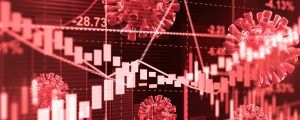Slowly at First, Then All at Once: Understanding The Threat of a Global Economic Collapse
Posted onThe Delta variant has taught us – for the second time – just how fast the future can change. What was supposed to be a continued recovery reversed in mere months. Today, the outlook for the globe is dimming. 
Originally the threat presented by COVID was clear: social distancing and illness meant that economic activity fell dramatically. Nearly two years later the picture has changed. The threats are more numerous and more complex.
Consider the food distribution challenges experienced in the UK. Recently, the Food and Drink Federation (FDF) explained that the industry is suffering from a shortage of about half a million workers. One reason: many workers shifted to new jobs in online retail during the pandemic. It is unlikely that any of those who made this switch will go back to their old jobs because their previous work was more demanding and lower paying. Ian Wright, the CEO of the FDF, explained that this “is a structural change that won’t reverse itself.” As a result, UK shoppers are facing a future in which the availability of various foods in restaurants and supermarkets will be unpredictable.
This situation is not a collapse by any means, but it does illustrate the complex and unexpected ways in which COVID is restructuring our lives today and in the future. Other changes, however, are more sobering.
Nomura, a global financial services group spanning 30 countries has created what they call an “early warning model for financial crises.” The system combines five early warning indicators including, private credit-to-GDP ratio, debt service ratio, real property price, real equity price, and real effective exchange rate. These indicators are examined across 40 economies. Since the early 1990s the system, called “Cassandra” in reference to Greek mythology, has correctly warned of two-thirds of the past 53 financial crises that have occurred.
Robert Subbaraman, the Managing Director at Nomura, explains that “a crisis takes a much longer time coming than you think, and then it happens must faster than you would have thought.” Today he believes that the environment of rock-bottom interest rates and increasing asset purchases by central banks have made several countries vulnerable to an economic crisis.
The model tells us that any country with a score over 100 is at an elevated risk.
The US has a Cassandra score of 195.
What makes this score so frightening is the fact that so much of the euphoria in the equity markets seems to ignore the looming threats. Stocks in US indexes have enjoyed a major rally YTD. This suggests that many do not understand what lies ahead or are choosing to ignore it.
This dynamic illustrates why “Cassandra” is the perfect name for the model. The Greek mythological character Cassandra was bestowed the gift of prophecy. This power, however, became a burden when Apollo cursed Cassandra thereby ensuring that nobody would ever believe any of her warnings. For the rest of her life, she was doomed because she knew when danger was around the corner but could do nothing to stop it.
To preserve capital, individual investors need to break the curse and listen to the warnings issued by our modern-day Cassandra. Now is the time to rethink investing strategies and ensure the right portion of assets are held in durable stores of wealth.
Want to read more? Subscribe to the Blanchard Newsletter and get our tales from the vault, our favorite stories from around the world and the latest tangible assets news delivered to your inbox weekly.







